A record of outings 2015
by Hugh Deam
Mini outing
Saturday 3rd October 2015
10:30 Aylesbury
St Mary (8) 21-2-12 in Eb · Bucks HP20 2QZ
12:15 Chinnor
St Andrew (6) 10-0-20 in G · Oxon OX39 4QL
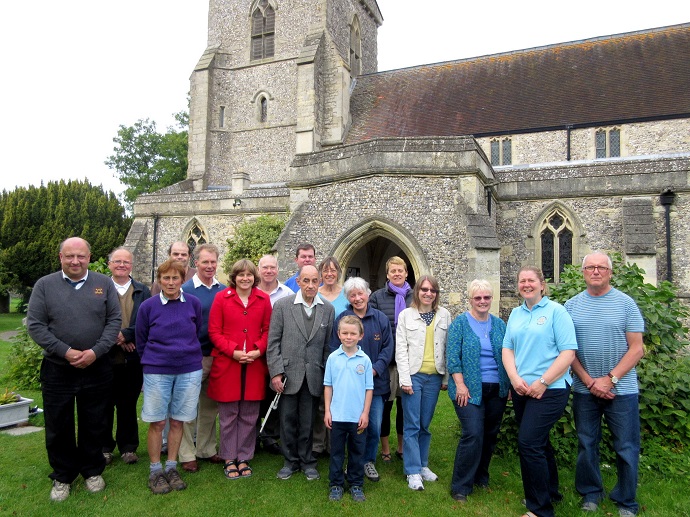
The ringers at Chinnor
Heather Banyard, Janice Beale, Jonathan Beale, Jane Burgess, Ron Burgess, Mary Carroll, Hugh Deam, Charlotte Furneaux, Michael Haines, Susan King, Judy Kirby, Paul Lucas, Bernard Masterman, Michel Probert, Charlotte Ritchie, Colin Taylor and Darren Washington.
Stedman Triples, Grandsire Triples, Plain Bob Triples, Cambridge Minor, St Clements Minor and Little Bob Minor.
During the 16th century the greater part of Aylesbury was in the ownership of Thomas Bullen, with county town status conferred by Henry VIII in 1529 whilst he was still in the - metaphorically speaking - "honeymoon" period of his fateful relationship with Bullen's daughter, Anne. Some three centuries later during the Napoleonic Wars, Hartwell House was the residence of the exiled future king of France, Louis XVIII. The document of acceptance of the French crown was signed by Louis in the library of the house. His wife, Marie Josephine of Savoy died at Hartwell in 1810 and was buried in the churchyard, thus becoming the only French queen to be buried on English soil. The town's heraldic crest is centred on the Aylesbury duck, a distinctive breed of domesticated duck with white plumage, a pink bill, with orange legs and feel. Given the town's royal heritage it is hardly surprising that the distinctive 13th century parish church and its location, St Mary's Close, bear the hallmarks associated with an abbey or cathedral. Although the interior of the church is significantly Victorianized, the necessity for renovation was pressing given the dilapidated state of the church at that time, with the roof leaking, undermined foundations, three fire engines housed in a chapel, and the local regiment injudiciously storing their gunpowder here. The church briefly hit the national headlines in 2013 with the discovery of an ear in the churchyard. The area having been cordoned off for a day or so, the subsequent forensic examination determined it to be a pig's ear. Thankfully, we managed to keep the standard of ringing above anything that could be described in terms of a porcine lobe.
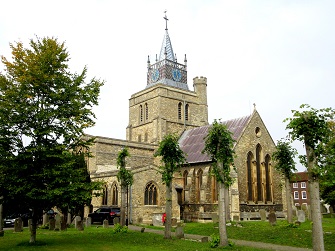
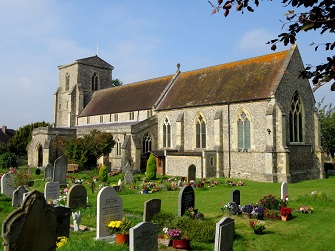 The seemingly sprawling village of Chinnor was actually conceived as a quadrangle layout at a crossing of route-ways on the Chiltern escarpment. After a busy session of ringing encompassing seven different methods the majority of our party decamped to the Village Centre for lunch. Staffed by volunteers, the centre celebrated its twentieth anniversary this year and has featured in the national media for being the template for other such community based hubs across the country. Adam Clayton, the bassist with the rock band U2 was born in Chinnor, and the former senior BBC weather forecaster, Bill Giles has lived in the village for many years, so the long range forecast could well have been for a beautiful day and so it transpired on what was a celebration of the mysterious ways of ringing.
The seemingly sprawling village of Chinnor was actually conceived as a quadrangle layout at a crossing of route-ways on the Chiltern escarpment. After a busy session of ringing encompassing seven different methods the majority of our party decamped to the Village Centre for lunch. Staffed by volunteers, the centre celebrated its twentieth anniversary this year and has featured in the national media for being the template for other such community based hubs across the country. Adam Clayton, the bassist with the rock band U2 was born in Chinnor, and the former senior BBC weather forecaster, Bill Giles has lived in the village for many years, so the long range forecast could well have been for a beautiful day and so it transpired on what was a celebration of the mysterious ways of ringing.

Aylesbury · St Mary

Chinnor · St Andrew
Witney and Woodstock practice
Saturday 26th September 2015
Stanton Harcourt
St Michael (6) 11cwt in F · Oxon OX29 5RJ
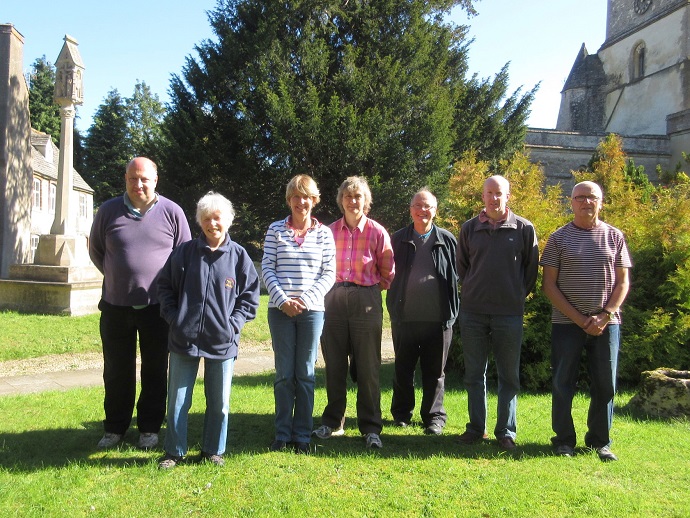
Stanton Harcourt · St Michael
Stanton Harcourt has been described in an earlier outing. Please refer to that one instead.
Charlotte and Lindsay’s outing
Monday 21st September 2015
10:00 Bodicote
St John Bapt (8) 8-1-4 in A · Oxon OX15 4DW
11:30 Great Tew
St Michael & AA (8) 22-0-10 in D · Oxon OX7 4AG
13:00 The Falkland Arms
The Green · Great Tew OX7 4DB
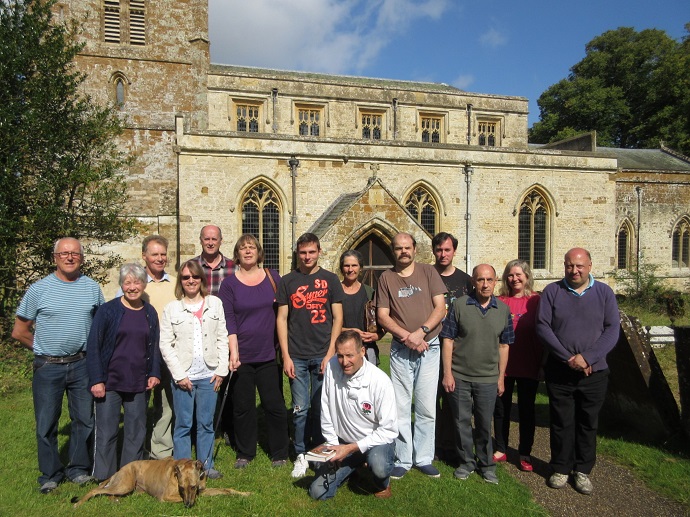
Great Tew · St Michael & All Angels
Charlotte Furneaux wites A misty morning greeted us as we arrived in the North Oxfordshire village of Bodicote to ring at St John the Baptist, the first of two eight bell towers within the Banbury Branch of the ODG. This visit was a trip down memory lane for me, as this is where I learnt to ring as a child and was taught by Ron Thorne. On my arrival I was passed a copy of an old photo (not shown) of the ringing crew to help remind me of those times - which was a lovely gesture.
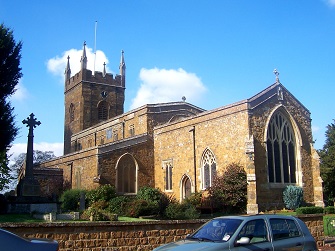
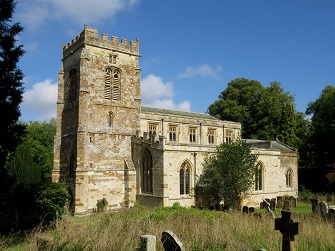 From here we travelled on to the magnificent church St Michael in the picturesque village of Great Tew. A point of interest for me was the 14th Century wall paintings displayed. In comparison to Bodicote, these were heavier bells with a long draft but rang surprisingly smoothly. Due to being at eight bell towers, this presented the opportunity for us to ring Grandsire Triples, Plain Bob Major, Plain Bob Triples and Plain Hunt on seven. For one ringer this was their first visit to an 8 bell tower.
From here we travelled on to the magnificent church St Michael in the picturesque village of Great Tew. A point of interest for me was the 14th Century wall paintings displayed. In comparison to Bodicote, these were heavier bells with a long draft but rang surprisingly smoothly. Due to being at eight bell towers, this presented the opportunity for us to ring Grandsire Triples, Plain Bob Major, Plain Bob Triples and Plain Hunt on seven. For one ringer this was their first visit to an 8 bell tower.
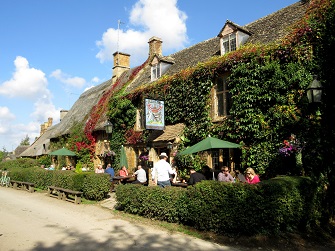
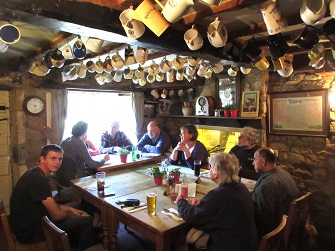 We were greeted with glorious sunshine at Great Tew for the group photo which included the ‘team mascot’, Charlie, Lindsay’s loveable dog, who enjoyed the walks at the towers as much as everyone else did the ringing! To finish off the day we had a pleasant lunch at the cosy pub - The Falkland Arms in Great Tew. A big thank you to everyone who came on this trip and for making it such a success!
We were greeted with glorious sunshine at Great Tew for the group photo which included the ‘team mascot’, Charlie, Lindsay’s loveable dog, who enjoyed the walks at the towers as much as everyone else did the ringing! To finish off the day we had a pleasant lunch at the cosy pub - The Falkland Arms in Great Tew. A big thank you to everyone who came on this trip and for making it such a success!

Bodicote

Great Tew

The Falkland Arms

Great Tew
Ringing up & down practice
Saturday 5th September 2015
10:30 Weston on the Green
Blessed Virgin Mary (6) 8cwt in A · Oxon OX25 3QS
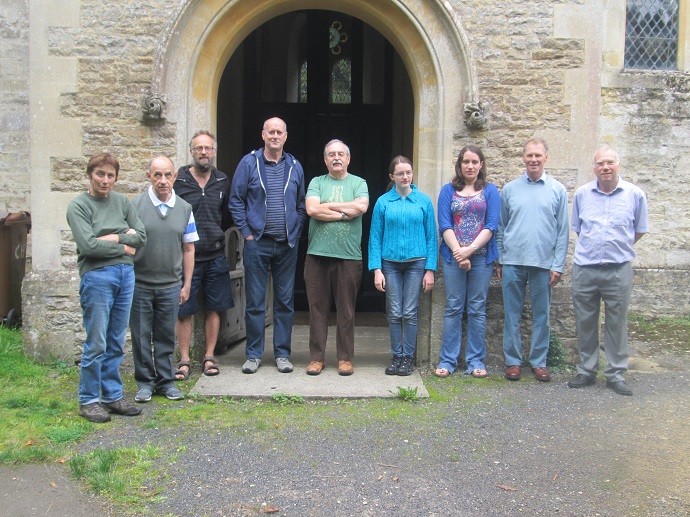
BVM
Jesus Anonuevo, Ron Burgess, Rosie Cretney, Hugh Deam, Catherine Godfrey, Keith Godfrey, Tim Hillsdon, Susan King, Bernard Masterman & Colin Taylor.
Weston on the Green The proximity of the Roman road, anciently known as Akeman Street, and the regular discovery of Roman coins in fields and gardens around the village is fairly conclusive as to habitation here many centuries before Weston's notation in the Domesday Survey. Further evidence is provided by the ridge and furrow farming that is still evident today, indicating early agricultural use. At the end of the 11th century, Robert d'Oilly gave the church and part of the manor land toward the foundation of St George's Chapel which was built within Oxford Castle. Two centuries later, Henry d'Oilly gave the manor to Osney Abbey, a position which pertained until the Dissolution. Weston Manor House, nowadays operating as a hotel, was built at the turn of the 15th to 16th century within a 13th century moat. The house was extensively renovated around 1851 and the moat was filled in on two sides in 1908.
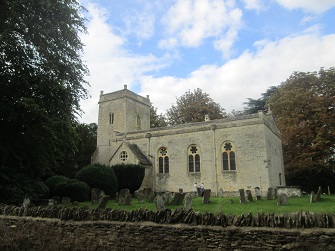
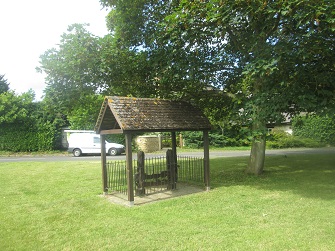 Although now renamed, the pub here was long known as the Ben Jonson, denoting the eminent Elizabethan writer who was apt to make this a half-way house during his visits to William Shakespeare in Stratford-upon-Avon. Just to the north of the village, RAF Weston on the Green was constructed in 1915 by Canadian military personnel and German prisoners of war for use by the Royal Flying Corps. In the 21st century it serves as a parachute training station and gliding club. Weston on the Green is one of the precious few villages in the county to retain its stocks, situated as they are on the central green. Dating to the 18th century, they are made of oak, with wrought-iron fixings and slotted posts for securing hands and feet. They were designated as Grade II Listed in 1987. Other amenities in the village include an ice-cream parlour, antiques centre & cafe and village shop. The lower part of the church tower is 11th century, pre-dating the main body of the church which has been rebuilt on a couple of occasions, most recently in the 18th century. In 1870, the original three bells were replaced with a set of five cast by Mears & Stainbank. They were augmented to a six in 2012 by Taylor's of Loughborough.
Although now renamed, the pub here was long known as the Ben Jonson, denoting the eminent Elizabethan writer who was apt to make this a half-way house during his visits to William Shakespeare in Stratford-upon-Avon. Just to the north of the village, RAF Weston on the Green was constructed in 1915 by Canadian military personnel and German prisoners of war for use by the Royal Flying Corps. In the 21st century it serves as a parachute training station and gliding club. Weston on the Green is one of the precious few villages in the county to retain its stocks, situated as they are on the central green. Dating to the 18th century, they are made of oak, with wrought-iron fixings and slotted posts for securing hands and feet. They were designated as Grade II Listed in 1987. Other amenities in the village include an ice-cream parlour, antiques centre & cafe and village shop. The lower part of the church tower is 11th century, pre-dating the main body of the church which has been rebuilt on a couple of occasions, most recently in the 18th century. In 1870, the original three bells were replaced with a set of five cast by Mears & Stainbank. They were augmented to a six in 2012 by Taylor's of Loughborough.

Weston on the Green · BMV

The stocks
Essex
Saturday 11th July 2015
11:00 Finchingfield
St John Baptist (8) 15-2-22 in Eb · Essex CM7 4NP
12:00 Wethersfield
St Mary Magdalen (8) 11-1-22 in F · Essex CM7 4BY
13:00 The King's Head
The Street · Gosfield · Essex CO9 1TP
14:15 Gosfield
St Catherine (6) 9-2-7 in G# · Essex CO9 1UD
15:30 Toppesfield
St Margaret (8) 14-2-14 in G · Essex CO9 4DR
Janice Beale, Jonathan Beale, Hugh Deam, Adrian Gray, Judy Kirby, Donna Murphy, Lindsay Powell, Michael Probert and Ailsa Reid.
Grandsire Triples, Plain Bob Minor, Little Bob Minor, Stedman Doubles and St Simon's Doubles.
Finchingfield Situated on the western edge of what has now been christened "Constable Country", the early settlement was documented as Phincingefelda (Open land of the family and followers of a local chief called Fine). In the wake of the Norman Conquest the lands here were given to Roger Bigod, one of the favoured knights of William the Conqueror. The central green in the village is arguably the most picturesque example in East Anglia, certainly being the most photographed and painted village green in the county, appearing on virtually every calendar of Essex beauty spots. The two greens and central duck-pond are surrounded by cottages and overlooked by hillside surmounted on one side by a recently restored 18th century post-mill and on the other, the 14th century parish church. The window ledge of the south aisle has several squares scratched on it, these relating to the medieval game of Nine Men's Morris. The lower stages of the tower are 12th century, with the upper stage from the 15th century. In the late 17th century a strong gale blew down the spire, and hence the distinctive cupola which houses an Angelus bell. All of the bells, bar the seventh, are from 1781 and cast in Down ham Market by Thomas Osborn. The seventh is from 1952 by Gillett & Johnson of Croydon.
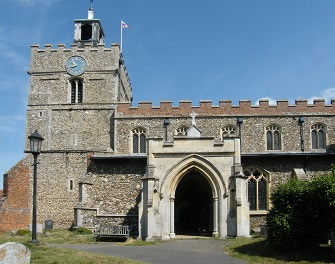
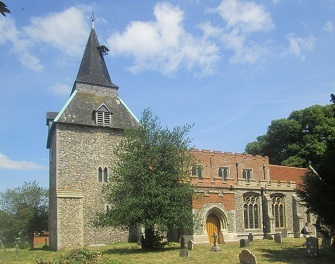 Wethersfield The Domesday Survey notes the settlement here as Witheresfelda (open land belonging to Wihthere). A significant number of the Pilgrim Fathers who settled the Plymouth Colony in Massachusetts came from the village, and as a consequence there are several towns named Wethersfield in the northern states of the Eastern Seaboard. The M.O.D. training facility here, MDPGA Wethersfield, began life as an RAF airfield between 1944 – 1946, later being reactivated to house the USAF 20th Tactical Fighter Wing from 1951 to 1970 as a result of the Cold War between the USSR and NATO. In 2014, the village was on the route of the final English stage of the Tour de France as Le Tour headed for London. Reverend Patrick Bronte, father of the Bronte sisters, served as a curate here in 1807. The tenor bell is from 1623, cast in Colchester by Miles Graye. All of the other bells were cast at Whitechapel, third to seventh during the 19th century, and the front two added in 1980.
The King's Head pub in Gosfield dates back to the late Tudor period with classic furnishings of a traditional countryside inn. Everyone left satisfied with their meal, with a goodly percentage of the menu being locally sourced.
Gosfield Noted as Gosfeld in 1198, the name literally describes open land frequented by wild geese. The manor house of Gosfield Hall retains its Tudor courtyard, although the house surrounding it has been remodelled a couple of times. In common with Wethersfield, there was an airfield constructed here during the Second World War, first used by the US 9th Air Force and then by the RAF Heavy Glider Servicing Unit. The parish church is primarily 15th and 16th century, with the west tower from the same period. Within the north chapel is the squire's pew, constructed for the Knight family of Gosfield Hall. The tenor bell, one of the oldest in the country, may well slightly pre-date the church, having been cast by Thomas Potter of Norwich around 1420. The fifth and third bells were cast in Sudbury in 1637 and 1704 respectively. The other three bells are all from 1962 and cast at the Loughborough foundry.
Wethersfield The Domesday Survey notes the settlement here as Witheresfelda (open land belonging to Wihthere). A significant number of the Pilgrim Fathers who settled the Plymouth Colony in Massachusetts came from the village, and as a consequence there are several towns named Wethersfield in the northern states of the Eastern Seaboard. The M.O.D. training facility here, MDPGA Wethersfield, began life as an RAF airfield between 1944 – 1946, later being reactivated to house the USAF 20th Tactical Fighter Wing from 1951 to 1970 as a result of the Cold War between the USSR and NATO. In 2014, the village was on the route of the final English stage of the Tour de France as Le Tour headed for London. Reverend Patrick Bronte, father of the Bronte sisters, served as a curate here in 1807. The tenor bell is from 1623, cast in Colchester by Miles Graye. All of the other bells were cast at Whitechapel, third to seventh during the 19th century, and the front two added in 1980.
The King's Head pub in Gosfield dates back to the late Tudor period with classic furnishings of a traditional countryside inn. Everyone left satisfied with their meal, with a goodly percentage of the menu being locally sourced.
Gosfield Noted as Gosfeld in 1198, the name literally describes open land frequented by wild geese. The manor house of Gosfield Hall retains its Tudor courtyard, although the house surrounding it has been remodelled a couple of times. In common with Wethersfield, there was an airfield constructed here during the Second World War, first used by the US 9th Air Force and then by the RAF Heavy Glider Servicing Unit. The parish church is primarily 15th and 16th century, with the west tower from the same period. Within the north chapel is the squire's pew, constructed for the Knight family of Gosfield Hall. The tenor bell, one of the oldest in the country, may well slightly pre-date the church, having been cast by Thomas Potter of Norwich around 1420. The fifth and third bells were cast in Sudbury in 1637 and 1704 respectively. The other three bells are all from 1962 and cast at the Loughborough foundry.
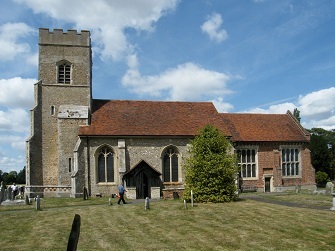
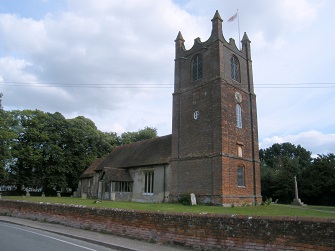 Toppesfield Referencing an area at the top of open land, the settlement here at the time of the Domesday Book (1086) was documented as Topesfelda. The village is situated amidst the hilliest terrain of the county, with the church tower being visible for a radius of about 10 miles. Constructed of flint rubble with limestone dressings, the 14th century church was extensively restored during the 19th century, with the west tower, constructed of brick, from around 1700. The oldest of the bells (5 -7) were cast by Antony Bartlet at Whitechapel in 1675, with the fourth a few years later, 1702, by Henry Pleasant, Sudbury. The other four bells are recent additions from the Loughborough foundry, 2007.
Toppesfield Referencing an area at the top of open land, the settlement here at the time of the Domesday Book (1086) was documented as Topesfelda. The village is situated amidst the hilliest terrain of the county, with the church tower being visible for a radius of about 10 miles. Constructed of flint rubble with limestone dressings, the 14th century church was extensively restored during the 19th century, with the west tower, constructed of brick, from around 1700. The oldest of the bells (5 -7) were cast by Antony Bartlet at Whitechapel in 1675, with the fourth a few years later, 1702, by Henry Pleasant, Sudbury. The other four bells are recent additions from the Loughborough foundry, 2007.

Finchingfield · St John Baptist

Wethersfield · St Mary Magd

Gosfield · St Catherine

Toppesfield · St Margaret
The Mendip Hills
Saturday 23rd May 2015
11:00 Radstock
St Nicholas (6) 11-0-25 in F# · Somerset BA3 3QG
12:00 Chewton Mendip
St Mary Magd (8) 24-1-1 in Eb · Somerset BA3 4SW
13:00 Old Down Inn
Emborough · Somerset BA3 4SA
15:00 Chilcompton
St John Bapt (12) 19-1-6 in Eb · Somerset BA3 4HP
16:00 Binegar
Holy Trinity (6) 8-3-25 in G · Somerset BA3 4UQ
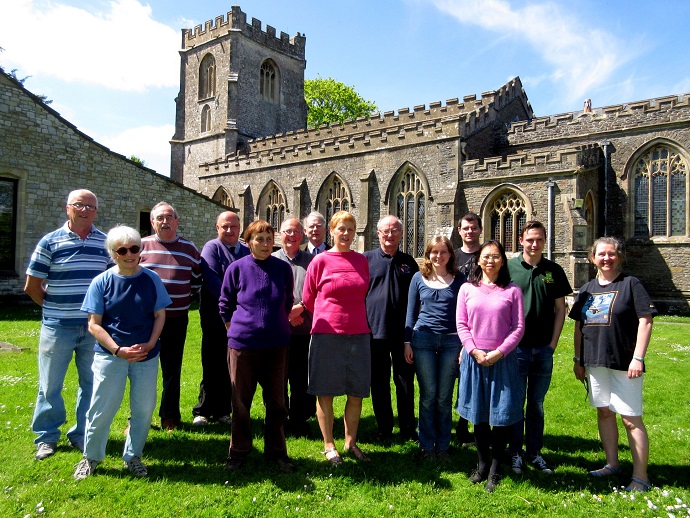
The ringers at Chilcompton
Jesus Anonuevo, Heather Banyard, Mary Carroll, Ollie Chaloner, Hugh Deam, Simon King, Susan King, Judy Kirby, Paul Lucas, Alison Merryweather-Clarke, Donna Murphy, Isaac O'Shea, Michael Probert, John Pusey and Kathy Xu.
Radstock Settled since the Iron Age, the town was noted merely as Stoche in the Domesday Book. The elongated name of today denotes that this was originally a stockade by a road, namely the Fosse Way. Radstock expanded more rapidly with the discovery of coal, and the subsequent opening of several mines in the area during the latter half of the 18th century. The parish church is a sensitive late Victorian rebuilding by local architects and craftsmen from nearby Bath, with the tower surviving from the 15th century. The four oldest bells date to 1740, cast by Thomas Bilbie in Chew Stoke at the foundry that existed a few miles to the west of here.
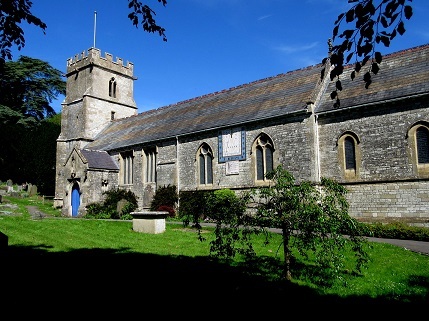
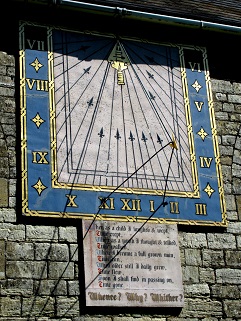 The other two bells (third and tenor) date to 1929, cast in Loughborough, at the time when Taylor's overhauled and retuned the bells.
Chewton Mendip Documented as Cheuton by Menedep in 1313, the name of the town amply describes a settlement in the midst of the Mendip Hills that is set alongside the River Chew. There are several caves amidst the Mendips, but the local cave, Attborough Swallet (also known as Red Quar Swallet), is unusual in that it is not comprised of the usual limestone, rather Dolomitic Conglomerate and marl, something more commonly found in Spain or Italy. The long distance footpath known as Monarch's Way follows the circuitous route thought to have been taken by Charles II after his defeat at the Battle of Worcester in 1651. The style of much of the housing gives evidence to the mining era, being reminiscent of hilly coal mining areas such as North Derbyshire or Nottinghamshire. The parish church is essentially 16th century, but has Saxon origins and Norman remnants such as the north doorway, with the tower added in 1541.
The other two bells (third and tenor) date to 1929, cast in Loughborough, at the time when Taylor's overhauled and retuned the bells.
Chewton Mendip Documented as Cheuton by Menedep in 1313, the name of the town amply describes a settlement in the midst of the Mendip Hills that is set alongside the River Chew. There are several caves amidst the Mendips, but the local cave, Attborough Swallet (also known as Red Quar Swallet), is unusual in that it is not comprised of the usual limestone, rather Dolomitic Conglomerate and marl, something more commonly found in Spain or Italy. The long distance footpath known as Monarch's Way follows the circuitous route thought to have been taken by Charles II after his defeat at the Battle of Worcester in 1651. The style of much of the housing gives evidence to the mining era, being reminiscent of hilly coal mining areas such as North Derbyshire or Nottinghamshire. The parish church is essentially 16th century, but has Saxon origins and Norman remnants such as the north doorway, with the tower added in 1541.
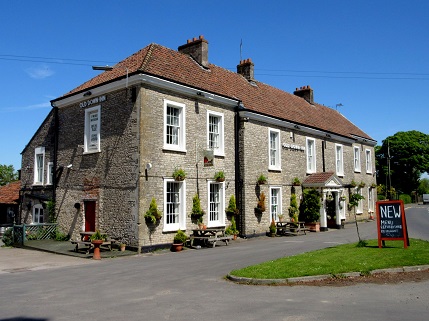
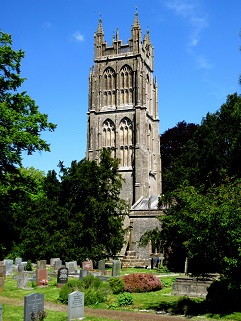 All eight bells were cast by Taylor's at the Loughborough foundry in 1913, and they are widely regarded as the best ring of eight in Somerset.
Chilcompton The name of the village literally describes a valley farmstead of the young men, being first noted as Comtuna. Chilcompton is situated on the northern slopes of the Mendips and for many years the primary source of employment came from farming and mining. Four street ponds flow alongside the road in the lower part of the village, characteristic for several towns and villages in this part of Somerset. The large parish church has been rebuilt twice, first in the 15th century and most recently during the 19th century, although the Perpendicular embattled tower remains from 1460. Long having been a six bell tower, the bells were recast and expanded to a ten around the Millennium, then augmented to a twelve in 2008. All of the present bells were cast at the Loughborough foundry.
All eight bells were cast by Taylor's at the Loughborough foundry in 1913, and they are widely regarded as the best ring of eight in Somerset.
Chilcompton The name of the village literally describes a valley farmstead of the young men, being first noted as Comtuna. Chilcompton is situated on the northern slopes of the Mendips and for many years the primary source of employment came from farming and mining. Four street ponds flow alongside the road in the lower part of the village, characteristic for several towns and villages in this part of Somerset. The large parish church has been rebuilt twice, first in the 15th century and most recently during the 19th century, although the Perpendicular embattled tower remains from 1460. Long having been a six bell tower, the bells were recast and expanded to a ten around the Millennium, then augmented to a twelve in 2008. All of the present bells were cast at the Loughborough foundry.
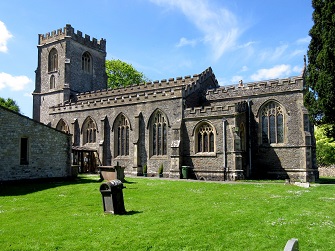
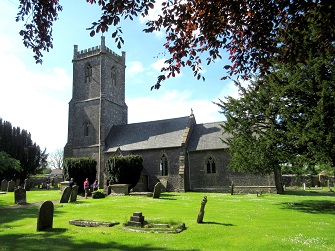 Binegar Gurney Slade to the east and Binegar to the west are essentially one village bisected by the A37, with the village welcoming signs listing both names. The name Binegar denotes a slope where beans were grown. In common with Chilcompton, the church here has twice been rebuilt, also in the 15th and 19th centuries, the latter being at the behest of the then vicar Reverend William Heade. Of the six bells, the oldest is the second, cast in 1634 by John Lott, Warminster. The fourth and tenor were among the last to be cast by the Bilbie family at their foundry in Chew Stoke before they moved their business to Devon. The other bells are all from the Loughborough foundry, 1937. Although rung from the ground floor and lacking any guides the bells are surprisingly easy to ring.
Binegar Gurney Slade to the east and Binegar to the west are essentially one village bisected by the A37, with the village welcoming signs listing both names. The name Binegar denotes a slope where beans were grown. In common with Chilcompton, the church here has twice been rebuilt, also in the 15th and 19th centuries, the latter being at the behest of the then vicar Reverend William Heade. Of the six bells, the oldest is the second, cast in 1634 by John Lott, Warminster. The fourth and tenor were among the last to be cast by the Bilbie family at their foundry in Chew Stoke before they moved their business to Devon. The other bells are all from the Loughborough foundry, 1937. Although rung from the ground floor and lacking any guides the bells are surprisingly easy to ring.

Radstock · St Nicholas

The sundial

Old Down Inn · Emborough

Chewton Mendip

Chilcompton · St John Bapt

Binegar · Holy Trinity
An Oxfordshire outing
Saturday 25th April 2015
With the Kidlington ringers
10:00 Rousham
St Leonard St James (6) 8-1-13 in Ab · Oxon OX25 5PB
11:00 Lower Heyford
St Mary (6) 6-3-20 in Bb · Oxon OX25 5NR
12:00 Somerton
St James (8) 11-3-23 in F · Oxon OX25 6NB
13:15 The Bell
21 Market Square · Lower Heyford · Oxon OX25 5NY
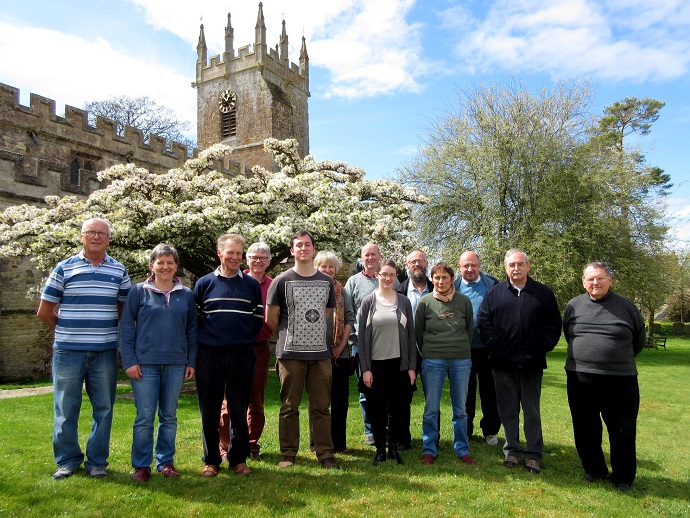
Somerton · St James
Jesus Anonuevo, Hugh Deam, Christine Fenn, Catherine Godfrey, Keith Godfrey, Toby Goss, Tim Hillsdon, Susan King, Paul Lucas, David Parks, Nora Tarczy-Novac, Colin Taylor and Peter Trowles.
Grandsire Triples, Plain Bob Minor and Stedman.
Rousham Deriving its name from the Anglo Saxon description of Hrothwulf's farm, the village would more accurately be described as a hamlet (population of 80 at last census), as it comprises just a handful of farmhouses spread across the estate lands. The Jacobean mansion of Rousham House dates to 1635, having been constructed originally for Sir Robert Dormer and has remained the property of the same family ever since.
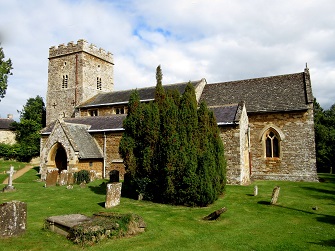
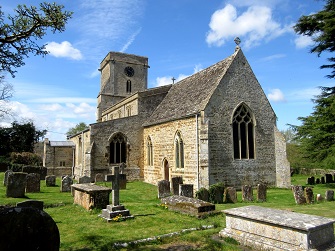 The house and its inspiring gardens, set around a curve of the River Cherwell, were remodelled by the artist William Kent during the mid 18th century. The layout of the gardens is a mix of the original work by Charles Bridgeman and the enhancements of Kent, with its classic beauty having gained in widespread repute over the intervening years. William Kent was also responsible for the design of the gardens at Stowe, Badminton, Chiswick and Chatsworth. The church on the estate dates to the 12th century, with the tower added a century later. The original dedication was to St Germanus of Auxerre, followed by St Mary, and then its latest dedication from 1904.
The house and its inspiring gardens, set around a curve of the River Cherwell, were remodelled by the artist William Kent during the mid 18th century. The layout of the gardens is a mix of the original work by Charles Bridgeman and the enhancements of Kent, with its classic beauty having gained in widespread repute over the intervening years. William Kent was also responsible for the design of the gardens at Stowe, Badminton, Chiswick and Chatsworth. The church on the estate dates to the 12th century, with the tower added a century later. The original dedication was to St Germanus of Auxerre, followed by St Mary, and then its latest dedication from 1904.
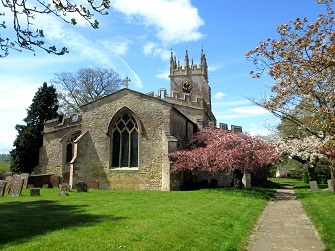
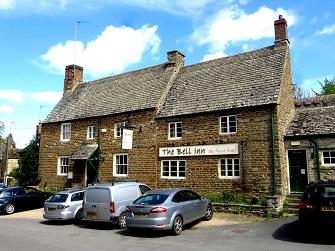 The large churchyard is immaculately maintained, boasting fine examples of topiary work and graced by martins and swifts in the summer months. The chances are that you will encounter one or more of the estate's peacocks on the walk from the car park to the church. Five of the bells are from 1675, cast by Richard Keene in Woodstock, with the fourth bell by Thomas II Mears (Whitechapel) 1825.
Lower Heyford and Somerton See Saturday 18th May 2013 for their descriptions.
The Bell Inn Located on the Market Square at the northern end of Lower Heyford village, the building dates to the 17th century and has been operating as a pub since 1817.
The large churchyard is immaculately maintained, boasting fine examples of topiary work and graced by martins and swifts in the summer months. The chances are that you will encounter one or more of the estate's peacocks on the walk from the car park to the church. Five of the bells are from 1675, cast by Richard Keene in Woodstock, with the fourth bell by Thomas II Mears (Whitechapel) 1825.
Lower Heyford and Somerton See Saturday 18th May 2013 for their descriptions.
The Bell Inn Located on the Market Square at the northern end of Lower Heyford village, the building dates to the 17th century and has been operating as a pub since 1817.

Rousham

Lower Heyford · St Mary

Somerton · St James

The Bell · Lower Heyford
Spring outing to Hampshire
Saturday 21st March 2015
Highclere
St Michael & AA (8) 11-0-27 in G · Hants RG20 9RH
Burghclere
The Ascension (6) 8cwt in Bb · Hants RG20 9HX
The Star Inn
Newbury Road · Kingsclere · Hants RG20 4SY
Kingsclere
St Mary (8) 13-0-14 in E · Hants RG20 5ND
Hannington
All Saints (6) 5-0-16 in Db · Hants RG26 5TZ
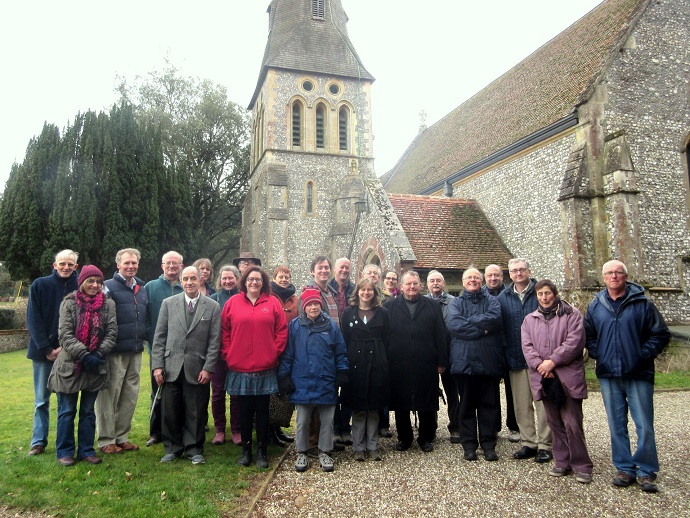
Highclere · St Michael & All Angels
Jesus Anonuevo, Heather Banyard, Mary Carroll, Hugh Deam, Victoria Echeveria Wylie, Neil Ephgrave, Charlotte Furneaux, Toby Goss, Tim Hillsdon, Anthony Hughes, Simon King, Susan King, Judy Kirby, Paul Lucas, Bernard Masterman, Alison Merryweather-Clarke, Donna Murphy, David Parkes, Lindsay Powell, Michael Probert, John Pusey, Charles Smith, Colin Taylor & Richard Bennett.
Little Bob Major, Stedman Triples, Kingsclere Triples, Grandsire Triples & Cambridge Minor.
Highclere Castle is the largest mansion in Hampshire, with the styling of the capacious parkland grounds being the work of Lancelot Capability Brown, over the period of 1774 – 77, for the Earl of Carnarvon. The house was remodelled and all but rebuilt in the Elizabethan style by Sir Charles Barry between 1839 – 42 for the 3rd Earl. Since 2010 Highclere has become one of the most recognizable houses in the world thanks to the phenomenal success of the ITV period drama Downton Abbey. Although 13th century in style, the parish church is actually much later, dating to 1869/70, designed by Sir George Gilbert Scott and constructed of flint and stone. The north-east tower is capped by a broach spire, with all of the bells cast in Loughborough, the back six dating to 1871 and the front two added in 1928.
Burghclere The village is situated in the shadow of the ancient hill-fort Beacon Hill which rises to an elevation of 850 ft. On 10th September 1910, the aviator Sir Geoffrey de Havilland made his first successful test flight from here. A memorial stone was erected on Seven Barrows field.
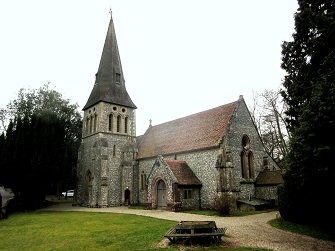
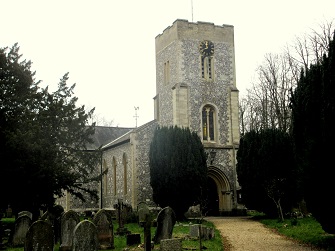 The tomb of the famed Egyptologist, the 5th Earl of Carnarvon is sited on the hill. Sandham Memorial Chapel was built during the 1920s as a memorial to Lt HW Sandham who was killed in action during the First World War. Designed by Lionel Pearson, its chapel houses a series of paintings by the English artist Stanley Spencer. There are two churches in the village due to a population shift northwards in the 19th century. This new church was built originally as a chapel of ease, but later enlarged in 1874/75. The spire which was added at this time subsequently proved a liability and was eventually removed in 1964. Three of the bells were transferred here from All Saints church, with the church organ also brought in from another church.
Kingsclere The inception of the Royal Manor, referred to in the Anglo-Saxon name, was during the reign of King Alfred. Local legend has it that King John, when prevented by fog from reaching his hunting lodge at Cottington's Hill, was troubled in his sleep by a bedbug during the unscheduled night's stay at the local inn. As a result he is said to have ordained that the church should erect and maintain upon its tower a representation of the creature that ruined his sleep.
The tomb of the famed Egyptologist, the 5th Earl of Carnarvon is sited on the hill. Sandham Memorial Chapel was built during the 1920s as a memorial to Lt HW Sandham who was killed in action during the First World War. Designed by Lionel Pearson, its chapel houses a series of paintings by the English artist Stanley Spencer. There are two churches in the village due to a population shift northwards in the 19th century. This new church was built originally as a chapel of ease, but later enlarged in 1874/75. The spire which was added at this time subsequently proved a liability and was eventually removed in 1964. Three of the bells were transferred here from All Saints church, with the church organ also brought in from another church.
Kingsclere The inception of the Royal Manor, referred to in the Anglo-Saxon name, was during the reign of King Alfred. Local legend has it that King John, when prevented by fog from reaching his hunting lodge at Cottington's Hill, was troubled in his sleep by a bedbug during the unscheduled night's stay at the local inn. As a result he is said to have ordained that the church should erect and maintain upon its tower a representation of the creature that ruined his sleep.
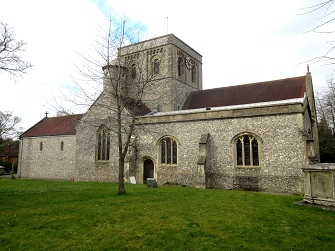
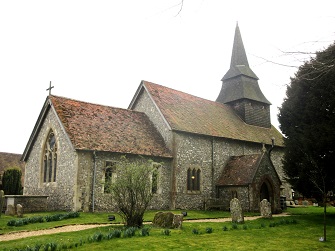 Bordering Kingsclere is Watership Down made famous as the setting for the 1972 novel by Richard Adams, and the charttopping song "Bright Eyes" from the subsequent movie. The parish church dates primarily to the rebuilding of 1848/49, although retainin some original stonework from the Norman period cruciform predecessor. A large 20th century war memorial dominates the churchyard. The five oldest bells date to 1664 by Henry Knight II of Reading, with the seventh from 1849 by John Taylor, and the front two added in 1962 by Mears & Stainbank. The vast ringing chamber well represents the broadness of the tower itself, thus allowing ample room even for a large group of ringers. Our lunch was partaken at The Star Inn, a converted 19th century farmhouse, the evidence of its former life still being present with the low-beamed ceilings and warming fire-places.
Hannington Situated amidst the North Wessex Downs, the Wayfarer's Walk trail passes through the village. The pub in Hannington is today known as The Vine, but was originally called The Wellington Arms due to the Duke's ownership of the land here at that time. The exquisitely maintained village green is overlooked by the elegant parish church, which is primarily Victorian in its construction, although some Anglo-Saxon work does survive within the nave. The bells are rung from the ground floor, with the back three all from the 17th century, cast by the Knight family at the Reading foundry. The third is from 1946, Gillett & Johnson (Croydon), and the front two cast in 2010 by Bowditch & Higby (Wells, Somerset), who are primarily known for their construction of mini-rings such as the Charmborough Ring.
Bordering Kingsclere is Watership Down made famous as the setting for the 1972 novel by Richard Adams, and the charttopping song "Bright Eyes" from the subsequent movie. The parish church dates primarily to the rebuilding of 1848/49, although retainin some original stonework from the Norman period cruciform predecessor. A large 20th century war memorial dominates the churchyard. The five oldest bells date to 1664 by Henry Knight II of Reading, with the seventh from 1849 by John Taylor, and the front two added in 1962 by Mears & Stainbank. The vast ringing chamber well represents the broadness of the tower itself, thus allowing ample room even for a large group of ringers. Our lunch was partaken at The Star Inn, a converted 19th century farmhouse, the evidence of its former life still being present with the low-beamed ceilings and warming fire-places.
Hannington Situated amidst the North Wessex Downs, the Wayfarer's Walk trail passes through the village. The pub in Hannington is today known as The Vine, but was originally called The Wellington Arms due to the Duke's ownership of the land here at that time. The exquisitely maintained village green is overlooked by the elegant parish church, which is primarily Victorian in its construction, although some Anglo-Saxon work does survive within the nave. The bells are rung from the ground floor, with the back three all from the 17th century, cast by the Knight family at the Reading foundry. The third is from 1946, Gillett & Johnson (Croydon), and the front two cast in 2010 by Bowditch & Higby (Wells, Somerset), who are primarily known for their construction of mini-rings such as the Charmborough Ring.

Highclere · St Michael

Burghclere · The Ascension

Kingsclere · St Mary

Hannington · All Saints
Northamptonshire
Saturday 7th February 2015
11:00 King's Sutton
St Peter & St Paul (8) 14-2-0 in G · Northants OX17 3RJ
12:30 Brackley
St Peter (8) 13-2-27 in F · Northants NN13 7BZ
13:45 Rachel's Farm Shop
Turweston · Northants NN13 5JY
Hugh Deam, Simon Edwards, Neil Ephgrave, Clare Fairbarn, Malcolm Fairbairn, Charlotte Furneaux, Toby Goss, Michael Haines, Tim Hillsdon, Simon King, Susan King, Judy Kirby, Paul Lucas, Alison Merryweather-Clarke, David Parkes, Lindsay Powell and Michael Probert.
Plain Bob Major & Triples, Little Bob Major, Stedman Triples and Grandsire Triples.
King's Sutton Described as Sudtone (a southerly situated farmstead) in the Domesday Survey, the manorial affix dates to 1294 (Kinges Sutton) and references that this Royal Manor was held by William the Conqueror. During the Civil War the village was garrisoned by the Royalists, with the excavation of saltpetre locally resulting in gunpowder being made here. After a long dry spell during the early summer of 1785, a devastating fire swept across the village and destroyed forty houses out of a then total of just 150.
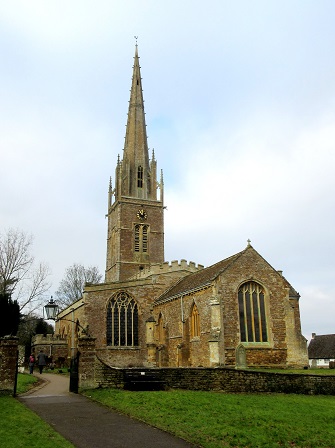
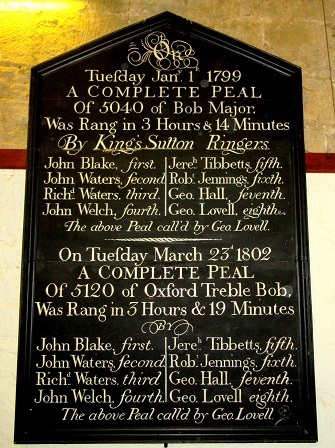 The oldest surviving parts of the parish church, the chancel and font, are Norman in origin. The north aisle was added in the 13th century and the south aisle in the following century, with a general restoration undertaken by Sir George Gilbert Scott in 1866. The tower is from the Decorated period, with the majestic octagonal spire having been added late in the 14th century. Reaching a height of 198ft, the spire is visible for many miles around the Cherwell Valley, and is one of the most magnificent in the country, having notably been described by Sir Nikolaus Pevsner as being “the finest spire in a county of fine spires”. The church is floodlit in the evenings until 11.00pm, making the spire a landmark day and night. A peal board in the ringing chamber details two exceptionally early peals in the tower, a peal of Plain Bob Major from Jan 1st in 1799, and a peal of Oxford Treble Bob in 1802.
The oldest surviving parts of the parish church, the chancel and font, are Norman in origin. The north aisle was added in the 13th century and the south aisle in the following century, with a general restoration undertaken by Sir George Gilbert Scott in 1866. The tower is from the Decorated period, with the majestic octagonal spire having been added late in the 14th century. Reaching a height of 198ft, the spire is visible for many miles around the Cherwell Valley, and is one of the most magnificent in the country, having notably been described by Sir Nikolaus Pevsner as being “the finest spire in a county of fine spires”. The church is floodlit in the evenings until 11.00pm, making the spire a landmark day and night. A peal board in the ringing chamber details two exceptionally early peals in the tower, a peal of Plain Bob Major from Jan 1st in 1799, and a peal of Oxford Treble Bob in 1802.
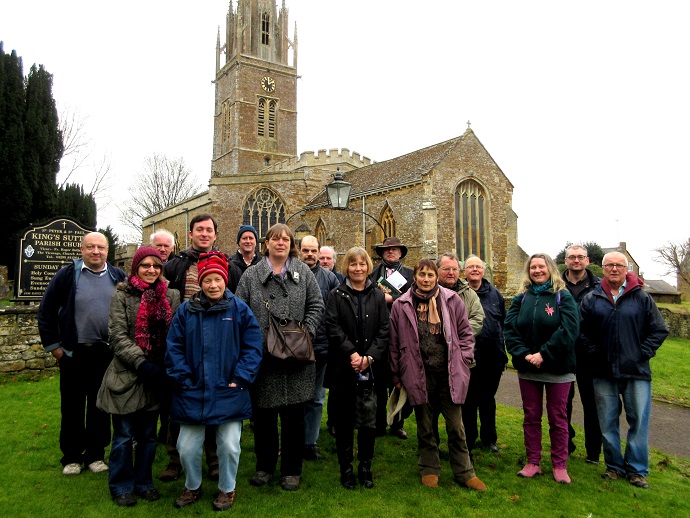 All of the bells, bar the sixth (1936), date to before these peals, the oldest being the seventh (1350), cast by John Rufford of Toddington.
Brackley Noted as Brachelai (a woodland clearing in the possession of Bracca) in 1086, this market town grew primarily on the trade in wool and lace. At the time of the Domesday Survey the land here was held by Earl Alberic, and during the following centuries ownership passed to various families with Royal connections, most notably the Earl of Leicester. The area south of the 11th century castle was used for Royal jousting tournaments during the reign of Richard the Lionheart. Forces loyal to Henry III attacked and destroyed the castle in 1173, with the site later being granted to the hospital of SS James & John.
All of the bells, bar the sixth (1936), date to before these peals, the oldest being the seventh (1350), cast by John Rufford of Toddington.
Brackley Noted as Brachelai (a woodland clearing in the possession of Bracca) in 1086, this market town grew primarily on the trade in wool and lace. At the time of the Domesday Survey the land here was held by Earl Alberic, and during the following centuries ownership passed to various families with Royal connections, most notably the Earl of Leicester. The area south of the 11th century castle was used for Royal jousting tournaments during the reign of Richard the Lionheart. Forces loyal to Henry III attacked and destroyed the castle in 1173, with the site later being granted to the hospital of SS James & John.
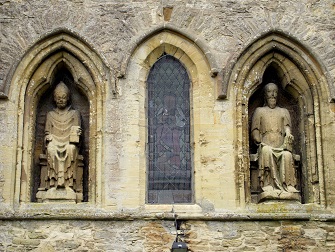
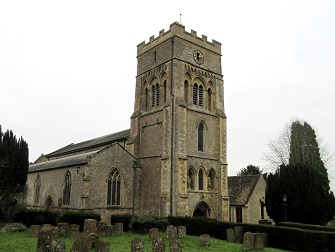 In 1150, Robert de Beaumont, 2nd Earl of Leicester, founded the hospital, with its master being a priest and its aim to provide accommodation and care for poor travellers. By the late 15th century it had strayed somewhat from its initial aims and control was granted to William Waynflete, Bishop of Winchester, who converted it into a school. Waynflete had founded Magdalen College, Oxford in 1458 and the associated school in 1480. The St James' Chapel was turned into the school chapel, a role which it still fulfills today. This is the oldest building in the country in continuous use as a school. With its close proximity to the Silverstone Grand Prix circuit, the town has in more recent years become synonymous with Formula 1 racing, with the championship winning teams of Brawn, and now Mercedes, being based here. The parish church is situated at the eastern side of of the town, with the 11 th century south doorway being the oldest surviving part, the church having been rebuilt from the late 13th to the early 14th century. The exterior of the C13th west tower has niches containing seated statues. The bells have been augmented twice by Taylor's of Loughborough (1890 & 1989), having originally been a four from 1628 by Hugh Watts of Leicester.
In 1150, Robert de Beaumont, 2nd Earl of Leicester, founded the hospital, with its master being a priest and its aim to provide accommodation and care for poor travellers. By the late 15th century it had strayed somewhat from its initial aims and control was granted to William Waynflete, Bishop of Winchester, who converted it into a school. Waynflete had founded Magdalen College, Oxford in 1458 and the associated school in 1480. The St James' Chapel was turned into the school chapel, a role which it still fulfills today. This is the oldest building in the country in continuous use as a school. With its close proximity to the Silverstone Grand Prix circuit, the town has in more recent years become synonymous with Formula 1 racing, with the championship winning teams of Brawn, and now Mercedes, being based here. The parish church is situated at the eastern side of of the town, with the 11 th century south doorway being the oldest surviving part, the church having been rebuilt from the late 13th to the early 14th century. The exterior of the C13th west tower has niches containing seated statues. The bells have been augmented twice by Taylor's of Loughborough (1890 & 1989), having originally been a four from 1628 by Hugh Watts of Leicester.

King's Sutton

A Peal Was Rang 1799 · 1802

Before King's Sutton St Peter & St Paul

We each sit within a niche

Brackley · St Peter